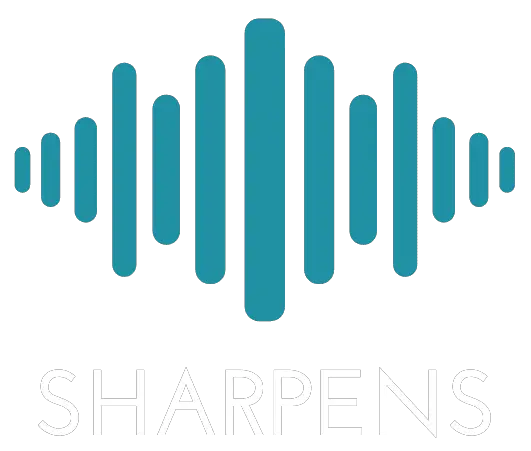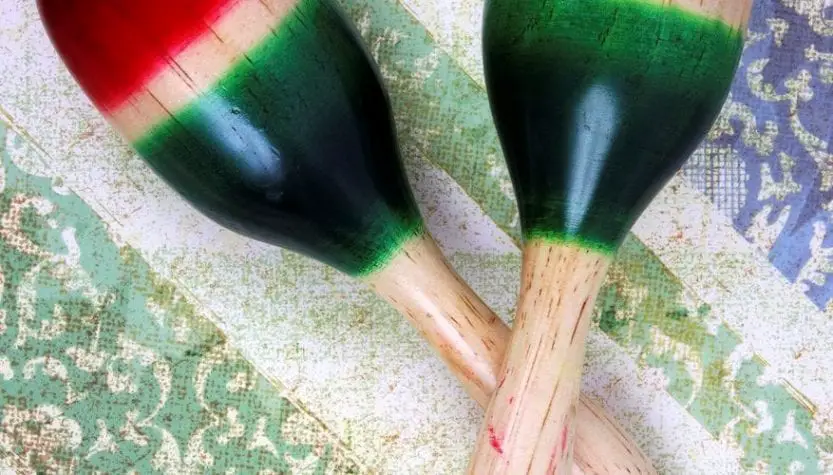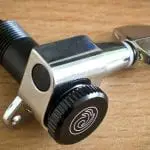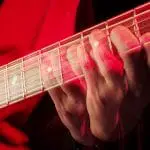Have you ever seen a guiro? If you’ve seen Latin American musicians perform classical songs and tunes, you may have seen a vegetable-like instrument played with a stick. This is a guiro and is known as one of the most popular percussion instruments in Latin America. Let’s find out more about this unique and interesting musical instrument and let’s learn how to play it as well.
What is Guiro?
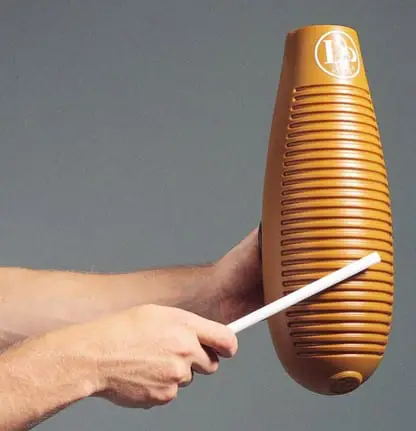
A guiro is native to Latin American countries and is classified as a percussion instrument. Yes, it’s a vegetable, and yes, it’s a gourd. The gourd has been hollowed out, dried, and treated with paint so that this can be used as an instrument. Notches are present on one side of the gourd, and these notches are played using a stick or by using tines. A typical guiro is around 16 inches long.
The sound that a guiro makes is described as a ratchet sound: rough, yet melodic. Is there a special kind of gourd used to make a guiro? Yes, folk music instrument makers prefer to use a long gourd with a wide body. There are different ways to play guiro too, and over many years, different musicians have developed their styles.
The guiro is used in Cuban, Puerto Rican, and other types of Latin American music. This instrument plays a huge role in creating the typical rhythm of some of the major genres like salsa, trova, and son.
To play this unique percussion instrument, you need to create long and short sounds that are done by moving a tool up and down the notches to create a rough, scraping sound.
The guiro is often held by the lead singer or backup singers like maracas. This instrument closely resembles the Cuban instrument called a guayo as well as the guira from the Dominican Republic. However, the main difference is that the guira and guayo are made of metal while the guiro is made of natural material. Still, more instruments are comparable to the guiro. There’s the guacharaca from Columbia, the reco-reco from Brazil, and the quijada made from a cow’s jaw and the washboard or the frottoir.
The calabash gourd is the most common type of gourd used to make a guiro. This type of gourd is hollowed out, and then parallel circular marks are carved at the shorter section of the gourd. Modern guiros are made from fiberglass or wood, but many Latin American musicians still prefer to use the traditional form of the guiro. They say that although the fiberglass and wooden versions are able to replicate the traditional guiro, the sound of a guiro made from a gourd is still the best and the most widely appreciated.
The parts of the guiro explained
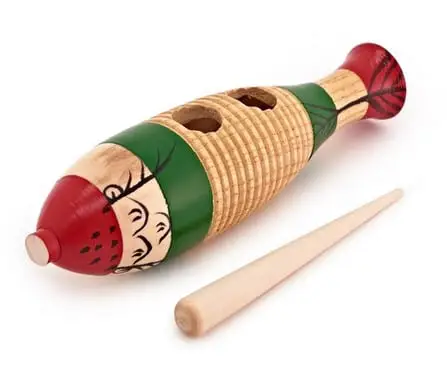
The different parts of the guiro are not just there for style. The first forms of the guiro were simply hollowed-out gourds with only a few ridges on one side with no holes at the back. The player had to find a way to grip the large gourd, usually placed the entire instrument on his forearm so he could scrape the notches easily.
Over time, this instrument received a facelift with the ridges covering almost all the middle part of the guiro and larger holes at the back was made so that the player can grip the instrument well. The body of the guiro is the prominent end, and it works as a resonator to improve the instrument’s sound.
Meanwhile, the ridges are more prominent as well, and thus the player can scratch, strike, and move the scraper on a larger surface area. The opposite end of the guiro remains open so that sound moves out of the hollowed instrument.
Some cultures use the gourd and other wooden pieces, but instead of creating ridges by carving the surface of the wood or gourd, they wrap cords or thick ropes around it. When struck or scraped, the cord creates a duller sound. It is played the same way as the original guiro. The original guiro (not wrapped in rope or cord) is classified as an idiophone, which is an instrument that creates sounds through the material from which this is made. There is no use of stretched skin, strings, or any enhancements.
Origin of a Guiro
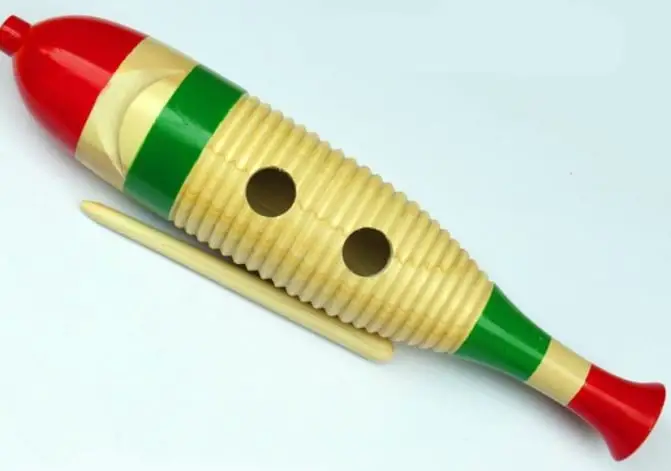
The guiro was fashioned from an instrument that may be first seen in South America or in Africa. Other cultures, like the Aztecs, also have an earlier version of the guiro known as the omitzicahuastli. This instrument was made from a bone with serrated sides, which were played similarly to the guiro.
In the Caribbean, the Taino people are known to be the first peoples to use the guiro. Tainos from Puerto Rico created an instrument known as the guajey. This is a long gourd, or they also used animal bones with notches. These were known as the ancestors of the modern guiro.
Many musicians say that the guiro originated in Africa and was taken to Latin America and in the Caribbean countries by slaves.
Uses of Guiro in music
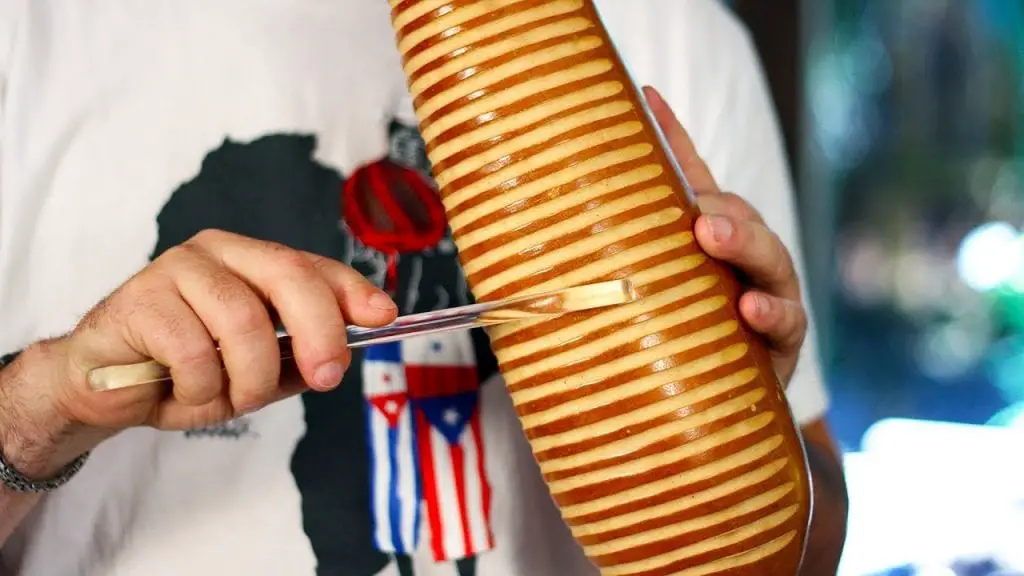
The guiro is a part of Latin American and Caribbean traditional, fold dance, and dance ensemble music that was played during religious ceremonies and festivals. The guiro is used in two Mayan folk dances in the Yucatan Peninsula called the jarana and the mayapax. This instrument is also used in the music genre called danzon in Cuba.
In Puerto Rico, this traditional percussion instrument is mostly played in jibaro music and genres like the plena, danza, and seis. Meanwhile, the guiro is used in fold dances, cumbia music, and traditional music on the Caribbean coast. If you’re in Panama, you will hear the guiro loud and clear in fold dances like the cumbia and merjorana.
The guiro is not just played in traditional and folk music but is also used in classical music. Classical musicians from Latin America say that the guiro adds local flavor and is used merely for the instrumental part of a song. A few examples of the guiro in classical music include the Uirapuru by Heitor Villa-Lobos, Le Sacre du Printemps, or The Rite of Spring by Stravinsky and Latin-American Symphonette by Morton Gould.
How to play the Guiro

To play the guiro, first, you need to be familiar with its parts. The gourd has two holes made into one side, and there are parallel grooves that were carved in a horizontal manner on the other side.
A wooden stick or a scraper is rubbed along these grooves to make a rasping or rough sound. The scraper can have all kinds of designs; one of the most popular is a scraper created out of a small piece of wood with metal prongs.
You can hold the guiro with two holes in two different ways. One is by placing your index finger on the hole and the middle finger on top of the other hole. You may also place your thumb to cover the top hole and place the rest of the guiro on the palm of your hands.
If you have a guiro with three holes, put your index finger on the center hole. Place the rest of your fingers around the instrument as if to hug it.
Now, hold the scraper using your opposite hand. Place your index finger around the scraper, just like holding a drumstick. You may also hold the scraper partly on the palm of your hands. Place your fingers around the wooden edge, and don’t touch the wires.
Move the scraper or the stick across the area to produce music. To create medium tempo music like the cha-cha-cha, move in an up and down manner producing quarter notes. To create a faster beat like the tempo in salsa, move it down and up.
You can produce all kinds of sounds in varying tempos with the guiro. And by using different types of scrapers to move across the notches. You can use wood of different kinds, sizes, shapes, and thicknesses. Lightwoods will produce light scraping while strong and tough woods can emit a very rough and loud sound. Other materials used are metal, plastic scrapers, shells, and bone.
The way you move the stick or the scrapper will also change the sound emitted by the guiro. You can follow the beat and tempo of a song, moving the tool up and down or up up or down down. Some musicians tap on the body of the gourd, which is another way to create a rich, dull, and pleasant sound.
Still, some musicians combine the sound of the guiro with other local, traditional musical instruments. As mentioned, the lead singer may hold the guiro and play it, or a separate musician can use it. Usually, only one guiro is used in a song, but some musical groups may play two or more at the same time.
Different variations in Guiro
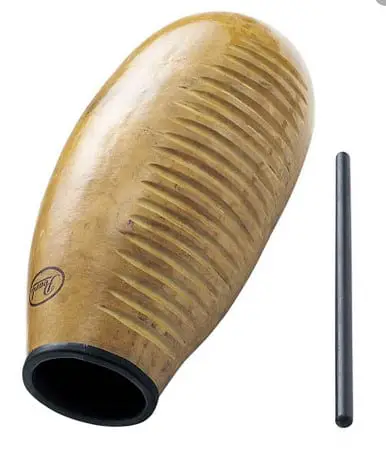
Now that you know how to play guiro, it’s time to get to know some different variations of this musical instrument. First and the most common is by holding the guiro from the holes and scraping the stick or the scraper from one end to another. This creates a long and rasping sound, especially when your scraper is made of wood, metal, or glass.
Another way is to hold the guiro from its two holes and then briskly to tap the center of the notches and then to scrap. A gentle and brisk tap or two and then one or two scrapes. Still another way is to move the scraper or tool in a circular manner but covering the entire grooved surface. The circular movement can be done quickly or slowly.
The guiro may also be played by tapping only a particular area on the notches. You can tap the upper or the lower part of the gourd, tapping the top once and the lower part twice or vice versa.
Watch any music video where this instrument is used, and you can see that the musician is not merely standing and playing the guiro like a robot. Usually, the musician moves his or her upper body, shoulders, arms, and even his or her hips. Some use the guiro while dancing and nodding to the beat.
And instead of holding the guiro in an upright manner, with the open part on top, you can also use it by holding it horizontally with the open end opposite your body. The sound is said to be louder this way and the scraping raspier and rougher.
The bottom of the guiro is usually supported by tape or any material that can protect it because this is the most commonly hit area. Some musicians place a small cotton pillow or a piece of leather inside the gourd to protect the bottom area.
Now, can you place things inside the guiro to enhance its sound? Guiros are hollow, and there must not be any kind of material or item placed inside when it is played. If you prefer something small like marbles and pebbles placed inside the gourd, then this is another kind of musical instrument called a rattle. If you prefer to place any kind of thing inside the gourd, place a cork on top to keep the materials from falling out.
Guiro and dancing
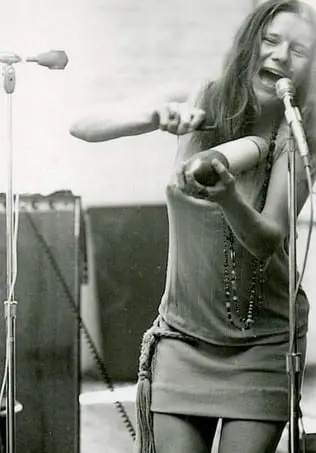
Most types of music that involves the use of the guiro have an upbeat tempo. Usually, musicians and singers would sing and dance while playing the guiro at the same time.
The design of the guiro makes it a portable and easy to carry percussion instrument too. The two holes at the back will allow you to grip it well while your other hand strikes the rough surface. Because of this, you can sing, dance, and even interact with your audience. It is also common to see the guiro in traditional festivals as musicians, singers, and dancers parade the streets.
Famous Guiro players
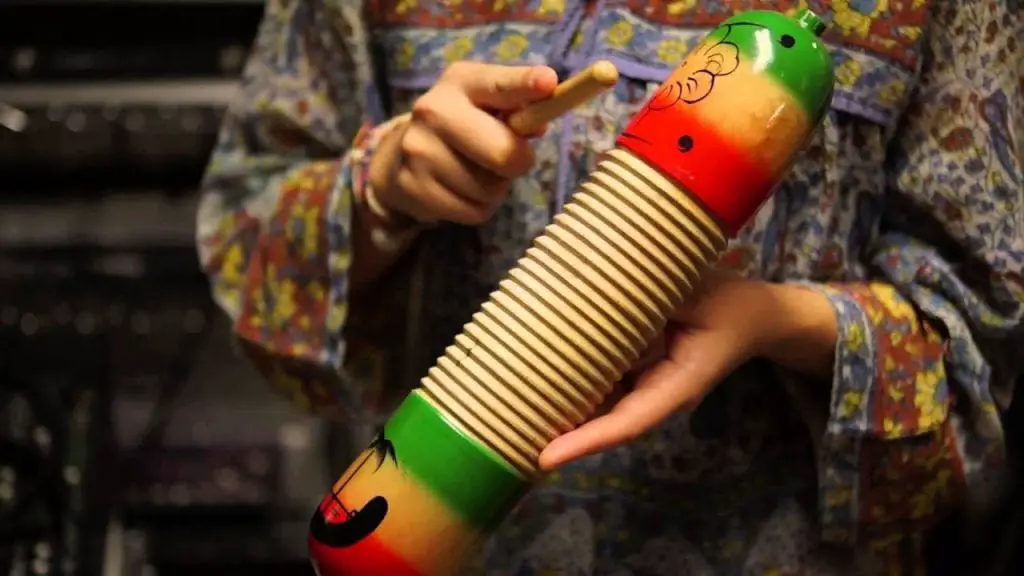
The following are noted musical artists who use percussion instruments like the guiro. These artists are popular in their type and genre of music, and all are multi-awarded artists as well.
Alejandro Neciosup Acuna
Alex Acuna is a drummer and percussionist from Peru. He is known for playing jazz, jazz fusion, pop, and Afro-Cuban jazz. Acuna has been active in the industry since he joined a local band when he was just ten years old. He was 18 when he joined Perez Prado and then moved to San Juan, Puerto Rico. Acuna has worked with very popular artists like Elvis Presley and diva Diana Ross.
Acuna is popular for his many awards and has played different musical instruments throughout his career. He is popular for playing the drums, conga, cowbells, timpani, triangles, bombos, wooden blocks, shekere, bells, castanets, djembe, darbuka, tamborim, and talking drum, to name a few.
Acuna has received the Best Latin/Brazilian Percussionist by the Modern Drummer’s Readers Poll. Acuna is so popular that several musical instruments have been named after him. Gon Bops Percussion has limited edition Alex Acuna Special Edition Congas, Signature Timbales, Special Edition Cajon, Signature Cajon, Special Edition Bongos, and Bells.
Ernesto Chico Alvarez Peraza
Another guiro player is Chico Alvarez, a Cuban North American singer that’s popular for singing Latin American music. Alvarez was born in New York City but moved to Cuba.
He has been performing throughout the tri-state area, and he is now with the Afro-Cuban group Marimba. To inspire people to appreciate Latin American music, he became the host of Latin jazz radio show New World Gallery at WBAI Pacifica Radio 99.5 FM.
Alvarez is known for playing different kinds of instruments, and one of these is the guiro. And because of his dedication to Latin American music and his impressive contribution to his field, he has received the National Federation of Community Broadcasters.
Ray Cooper
Raymond Cooper is an English musical artist, a session, and tour percussionist and has worked with diverse groups such as Billy Joel, Eric Clapton, Elton John, George Harrison, and Pink Floyd. His specialty is using unusual instruments such as the glockenspiel, cowbells, tubular bells, and traditional instruments like the guiro.
Cooper is mostly seen performing with a wide array of instruments. He would experiment with all kinds of percussion instruments to achieve sonic diversity in his works. He is into tambourines, roto toms, gongs, timpani, and snares, to name a few.
Paulinho da Costa
Paulo Roberto da Costa is a percussionist from Rio de Janeiro in Brazil. He is known as the most recorded musical artist of modern times. He started as a samba musician and moved to the United States in 1970, where he worked with Sergio Mendes. He has received the National Academy of Recording Arts and Sciences award for Most Valuable Player Award for three years. He also received an honorary Musician’s Emeritus Award.
His favorite musical instruments are all percussion instruments. He plays the conga drums, timbales, Cajon, maracas, atabaque, chimes, cowbells, shekere, log drums, samba whistle, rainmakers, cymbals, finger cymbals, all kinds of drums, wooden blocks and the guiro to name a few.
His popularity earned him a signature Paulinho da Costa timbale stick. This was designed for use on a variety of percussion instruments, and one of these is the guiro.
Other notable guiro players are Airto Moreira, Giovanni Hidalgo, and Joe Lala.
You can learn how to play the guiro through lessons offered online. Most people have their own style of playing it, and you can develop your own style as well.
